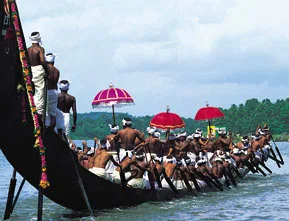Chundan Vallam- An ancient naval craftmanship withstanding the test of time
Chundan Vallam- An ancient naval craftmanship withstanding the test of time
A lush tropical paradise, Kerala is a coastal state located in the southern-west corner of India. Because of its serene backwaters, captivating landscape and ecological diversity, the state is nicknamed as God’s own Country. Besides its picturesque natural terrains, Kerala is a mosaic of diverse cultures woven from centuries of history.

Kerala in Frames (Image Courtesy : Kerala Tourism)
In the past, Kerala served as the confluence of various civilizations. Trade and migration had a profound influence on the local community. Hence, the harmonious coexistence of several religious communities in Kerala is a testament to its deep-rooted pluralism.
From classical dance forms such as Kathakali and Mohiniyattam to ancient martial arts like Kalaripayattu, several cultural practices have been passed down through generations. Vallamkali, a traditional boat race, is a practice that every Malayalee holds close to their heart.

Vallamkali (Image Courtesy: Kerala Tourism)
The term ‘Vallam’ means boat in Malayalam. The boats used in Vallamkali are called Chundan Vallam. The natives call it Chundan Vallam because the boat’s prow resembles a bird’s beak. Besides Chundan Vallam, these boats are also known as snake boats because of their striking, serpentine shape. Other alternative names for this naval boat are Kothumbu Vallam and Palliyodam. As per historical sources, Chundan Vallam originated in the 14th century during a war between feudal lords of Kerala.
Today, these naval crafts have shifted from their traditional boundaries and have inspired other cultural expressions, such as literature, murals, home décor, handicrafts, textiles and fashion, further entrenching the tradition in the cultural consciousness of the region.

Handicraft of Chundan Vallam (Image Courtesy: Amazon)
In fashion, Chundan Vallam has been exquisitely depicted in traditional textiles like sarees. Motifs of Chundan Vallam are either intricately hand-painted or embroidered on traditional sarees and other garments in vibrant colours. These designs showcase majestic snake boats gliding through the water with the assistance of synchronized oarsmen. The detailed artistry of these motifs is not just for decorative purposes. The depictions of Chundan Vallam on garments string the wearer to the rich maritime heritage of Kerala.

Chundan Vallam motif on sarees (Image Courtesy: https://paramacalcutta.com/products/kerala-snake-boat-saree)
From wooden cravings to metal sculptures, the Chundan Vallam motif is a recurring theme in handicrafts and home décor. Miniature versions of the Chundan Vallam made from wood or metal are popular souvenirs. These motifs are also prevailing themes in traditional lamp shades, pottery, wall hangings, and other home décor items.

Handicraft of Chundan Vallam (Image Courtesy: Flipkart)
In all these forms, Chundan Vallam is more than just a boat. It is a piece of storytelling connecting the local populace with their cultural identity and enriching past.

Vallamkali (Image Courtesy: https://vembanadlake.blogspot.com/2007/10/vallam-kali-boat-race.html )
Now let us look into the history, construction and cultural significance of Chundan Vallam-
Centuries ago, the king of Chempakassery suffered a bitter defeat at the hands of his rivals. The king believed his war boats were slow and unwieldy, leading to his defeat. Frustrated, the king reached out to his state artisans for the construction of better, speedier warboats. Kodipunna Venkida Narayanan Achari came up with the unique design of Chundan Vallam. He referred to the Sthapatya Veda, an ancient treatise detailing the laws of structuring. Built in line with the specifications in Sthapatya Veda, the Chundan Vallam showcased ancient artisans’ prowess in naval architecture. The Venkida family designed the first Chundan Vallam. Later, they became the official boat makers of the king.
What makes designs of Chundan Vallam more exceptional among boat-making techniques is their structural ability and high load-carrying capacity, thus standing out from existing war boats. These naval war crafts can carry over 100 paddlers and cannons. Furthermore, the use of indigenous materials and time-honored construction techniques reflect the meticulous craftmanship of expert artisans.
Till now, no written documents regarding its construction are available. Currently, the Venkida family have copyright ownership over the Chundan Vallam designs.
Years after the wars ceased, there was a change in the purpose and shape of these warboats. Initially, these boats came to be associated with temple processions and hence were called Palliyodam. Apart from their ritualistic purposes, these boats are also used for annual competitive water sports like the Nehru Trophy Boat Race held at Alappuzha.

Nehru Trophy Boat Race (Image Courtesy: Kerala Tourism)
Today, Chundan Vallam is an integral part of one of the most celebrated water sports and plays a critical role in preserving traditional boat-building techniques and their associated folklore.
Recent Stories
- Paithani: The Silky Indian Handloom
- From Florence to the Taj Mahal: The Global Journey of Pietra Dura
- The History of Guldaudi Patterns in Delhi – A Legacy of Floral Art and Craft
- Chundan Vallam- An ancient naval craftmanship withstanding the test of time
- The History and Significance of Naskh Calligraphy in Delhi
- Why Rajput Painting is a Treasure of Rajasthan’s Art Scene
- The Timeless Art of Chikankari: Embroidery of Elegance and Heritage
- Zari Zardozi: The Golden Thread of Delhi’s Heritage
Products
-
 Wooden Wall Platters - set of 2
Wooden Wall Platters - set of 2
₹999.00Original price was: ₹999.00.₹599.00Current price is: ₹599.00. -
 Chalice - Premium Wood
Chalice - Premium Wood
₹899.00Original price was: ₹899.00.₹399.00Current price is: ₹399.00. -
 Wooden Table Vases - set of 2
Wooden Table Vases - set of 2
₹1,599.00Original price was: ₹1,599.00.₹399.00Current price is: ₹399.00. -
 Small Table Vase - Wooden
Small Table Vase - Wooden
₹889.00Original price was: ₹889.00.₹299.00Current price is: ₹299.00. -
 AshTray - Premium Wood
AshTray - Premium Wood
₹1,399.00Original price was: ₹1,399.00.₹399.00Current price is: ₹399.00.








